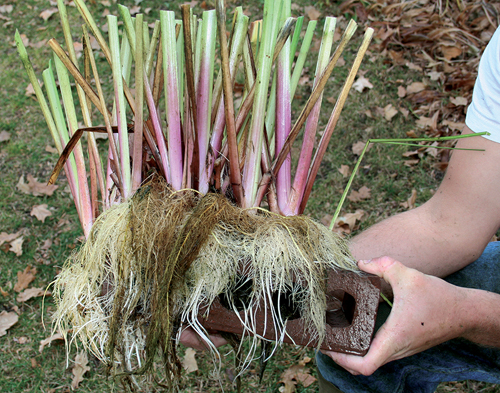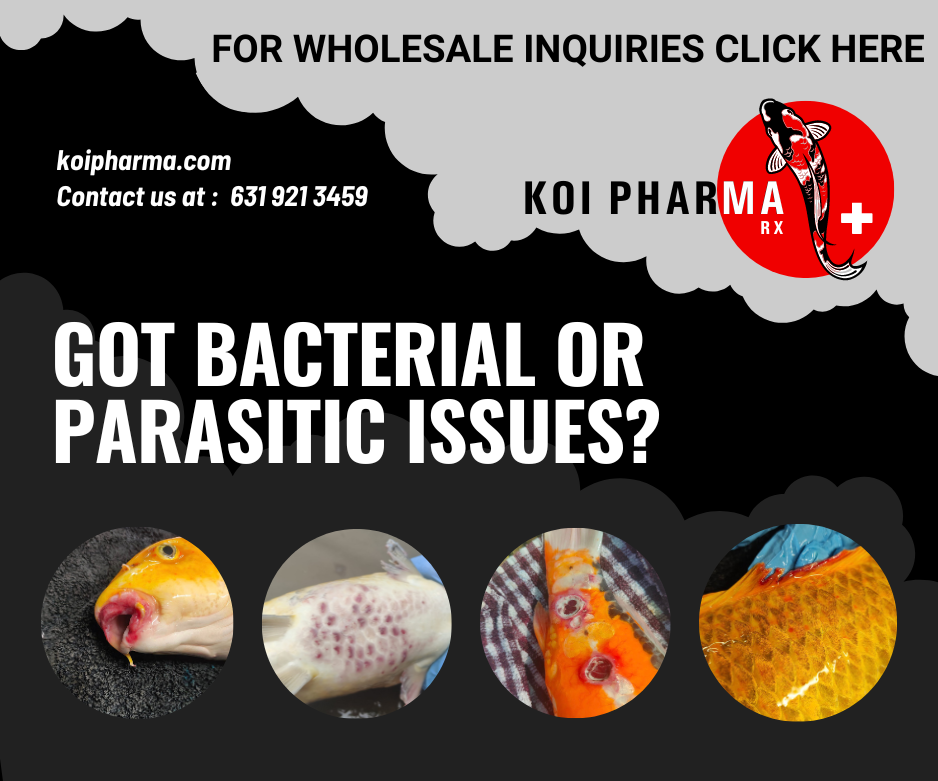
Every pond is as unique as its owner. This uniqueness results from a huge number of variables, including climate, size and style of pond, fish, plants, human involvement, circulation, filters…the list goes on. However, there is one aspect of all ponds that is the same. That is the pond’s biofilm, or what I like to call A Pond’s Patina (APP). This element is critical to pond management and my own ponds. APP is so important to a pond ecosystem that, even though I wrote about it nine years ago in the magazine Pondkeeper, I want to revisit the subject.
So what is APP? It is the layer of life that can exist on everything in an aquatic ecosystem that is in contact with well-oxygenated water. It is the pond’s natural biological filter. Most pond keepers know this as the “slime” layer that makes things slick. Many species of invertebrates and bacteria make up a large component of APP. Some are visible to the naked eye. Others are so small that a magnifying glass, dissecting scope or even a microscope is needed to see them. Critters like amoebas, worms, rotifers, aquatic insects and their larvae are just some examples. Literally tens of thousands of species can exist in a healthy pond’s ecosystem. It is not important to know all the kinds and be able to identify them. What is important is to know they exist and that you should do everything in your power to keep APP healthy.
There is another live component of APP that is critical for this microcosm of invertebrates and bacteria to prosper. That is algae! Yes, there are good species of algae that we need in our ponds. Patina algae provide a substrate for the critters to adhere to, and some even graze on it.
APP is on the rocks, liner, pots, all plant parts (including roots), in the filters and, to a lesser extent, in the water itself. Of course, the critters in the water are free-floating, and that is how some of them can colonize new surfaces, which most do. There are invertebrates that live their whole lives in the water column without attaching to any surface. The amount and type of patina varies with what it is attached to. For example, plant roots directly exposed to the water column will have a unique surface that certain critters thrive on. Water Hyacinths, with their roots dangling in the water, have heavily-colonized root zone micro ecosystems, providing a large surface area for diverse and healthy biological activity.Maintaining Equilibrium
Earlier I stated that one thing all ponds have in common is some sort of patina, but the amount will differ. There is an optimum equilibrium between the plants, good algae and critters. A new pond and its ecosystem are in a dynamic flux of changing populations. As the pond matures, this balance becomes more stable. The balance will still fluctuate with changing conditions, like weather, plant and fish populations, but not as dramatically. This balance can be easily upset. For example, adding a treatment for string algae could inadvertently kill all the algae in the pond, including the patina algae.

A ponderer can speed up this balance by adding bacteria, plants and muck from a healthy, mature water garden. However, time is still necessary for the development of healthy populations. A community of APP can mature faster in warmer climates than colder climates. It takes a minimum of two to three years for a Midwestern water garden to reach its best ecosystem equilibrium.
Once APP becomes mature, string algae is less likely to grow on that surface, which has already been populated by surface algae and APP critters. According to my own observations, the main body of a mature pond with APP equilibrium will not support the growth of string algae. The string algae will still grow in the stream because its patina died when the stream was shut down for winter.
Proper Pond Management
Now I want to introduce a new subject, called Proper Pond Management (PPM). This is the most critical part of cultivating a healthy patina. In most cases PPM requires far less work in maintaining the pond than what is normally done by some pond keepers.

One aspect of PPM involves creating good oxygen levels throughout the pond in both winter and summer. Low oxygen levels are the most limiting factor in APP development. Increasing circulation can decrease the potential for areas of low oxygen, or dead zones. Just how much circulation is enough? A rule of thumb for small ponds is to pump the water a minimum of one pond volume every one to two hours. For example, a 1,000-gallon pond must have a water pump with an output of 500 to 1,000 gallons per hour, or GPH. This water is directed to areas that create the best circulation within the pond. This rule can be adjusted down some in larger ponds of 10,000 to 15,000 gallons. A flow rate of 5,000 to 7,000 GPH (or one pond volume per three to four hours) for a 20,000-gallon pond is enough in most cases. Wintertime circulation rates can be lower, since the demand for oxygen decreases and cold water holds much more oxygen. But you still need some circulation in those cold months.
A four-letter word (that is actually five letters) that I say to never use or do is SCRUB. Never power wash or scrub the main body of the pond. APP has taken two to three years to mature, so to power wash it is just plain crazy. By doing this, the pond has been set back to new pond status. A majority of my clients want the “slime” removed. They want to see the beauty of the stone because, in their minds, this seems the most natural. However, the opposite is true. It takes some time to convince pond owners of the importance of this layer of life. A pond that does not have APP looks odd and unnatural to experienced pond keepers. Since the pond’s ecosystem has been disrupted, the pond will go through new pond cycles every year. This can require chemicals to control the cycles.
Attempting to grow a thicker layer of APP is not possible. The layer has an optimum thickness, above which the lower part of the patina will start to suffocate and slough off. Fish are also constantly grazing on it, which is healthy for the fish but does keep the layer only a millimeter or so thick.
Most ponderers shut down the stream in the fall, so the patina in a stream will die anyway. It is OK to power wash just the stream in the spring, but only right after startup, before the stream has been running for very long. That stream will colonize quickly once it is started, because the pond itself provides a huge population of critters to inoculate it.
Prevent excessive accumulation of organic load by keeping the leaves and sediment from building up and depleting the available oxygen.
The Power of Plants
PPM involves adding plants. As mentioned earlier, plants add a different type of substrate for APP to grow on. Plants also extract the end products of the ammonia cycle that are created by fish excretions and decomposition of organic matter.

for ponds. They not only utilize ammonia and other toxic byproducts of fish waste as well as organic matter decomposition, but they also provide a home for all kinds of small critters. These critters are the pond’s natural ecosystem. (Click to Expand Image)
PPM also means never overstocking fish or overfeeding them. This adds more ammonia for the patina to process. There is only so much APP can do.
Adding some kinds of chemicals or soaps can kill critters or algae. This might be appropriate for certain kinds of algae, but you may inadvertently kill the good kinds as well. Of course there are good additives, so know the possible consequences by doing your research.
When cleaning a pond, avoid letting the patina dry out. I will periodically spray the sides of the pond and all the stone with water as I am cleaning a pond. Even shutting a stream down for an hour or two can be lethal for the stream patina unless it is kept wet with a garden hose spray. Also, when cleaning a pond, try to save as much water as you can in temporary pools. As mentioned earlier, this water has a lot of critters in it. 100-percent-new water will change the pH as well as the temperature. So, it is less traumatic for the ecosystem (the fish and APP) if the saved water is used when transferring them back into the pond.
Finally, add surface area for APP to colonize. One way is by adding a biological filter. A properly designed biofilter is an ideal home for the patina. The types of critters in these filters is different than those on the rocks because these filters are dark and algae will not grow in them. Adding or lengthening a stream will increase surface area available for APP to grow on. Adding rocks to the sides of a pond will allow the patina to proliferate. Adding rocks to the bottom of a pond is pointless, since the sediment that covers the stone prevents the biofilm from forming. This area becomes anaerobic (without oxygen) and can be toxic. Besides, removing excess sediment in a rocked pond bottom becomes a tedious job.
To be a successful pond keeper you must do everything in your power to allow APP to prosper. Practice PPM and your clients will have a much more enjoyable water garden with less work. What is good for ponds’ natural biological filters is good for the fish, the plants and the beauty of water gardens.



Sou do Brasil e estou sempre traduzindo seus artigos. Tenho um lago de quintal e seus artigos me ajudam muito!
Assim, só me resta agradecer!
Deus abençoe você sempre!
I translated your comment:
I am from Brazil and I am always translating your articles. I have a quintal lake and its items help me a lot!
So, it only remains for me to thank you!
God bless you always!
Thanks for the kind words Geraldo. Glad you enjoy the magazine.
Lora Lee